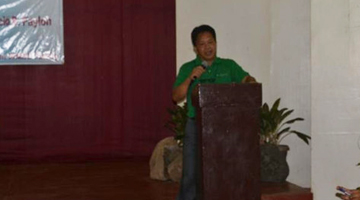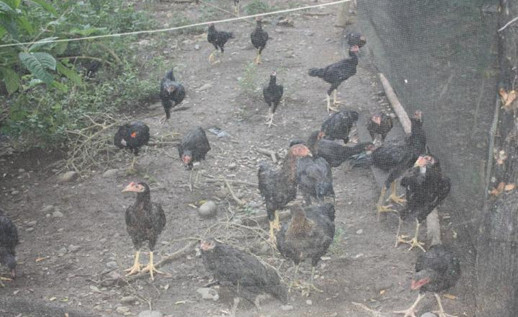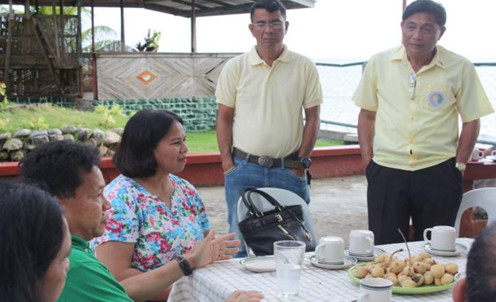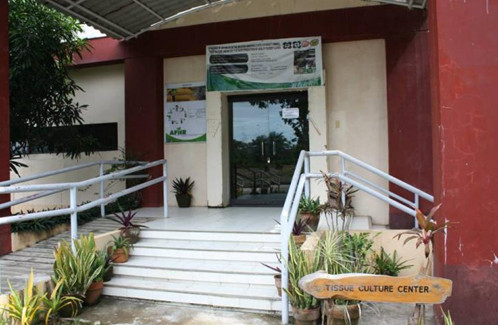 ZAMBOANGA CITY-- In a gesture of goodwill and appreciation of PCAARRD’s perennial support for its research and development efforts, the Western Mindanao State University (WMSU) honored the Council recently during an official visit of its Executive Director, Dr. Patricio S. Faylon, and several directors of the Council’s technical research divisions.
ZAMBOANGA CITY-- In a gesture of goodwill and appreciation of PCAARRD’s perennial support for its research and development efforts, the Western Mindanao State University (WMSU) honored the Council recently during an official visit of its Executive Director, Dr. Patricio S. Faylon, and several directors of the Council’s technical research divisions.
The simple ceremony attended by some WMSU faculty and students was conducted shortly before the Council’s monitoring and evaluation of its on-going funded projects which are implemented by the university.
Composing the Council’s R&D retinue were Dr. Edwin C. Villar and Dr. Synan Baguio, Director and Assistant Director, respectively, of the Livestock Research Division; Dr. Feliciano G. Calora, Jr., and Dr. Marcelino U. Siladan, Director and Assistant Director, Forestry and Environment Research Division; Dr. Mary Ann Acedera, Director, Marine Research Division; Dr. Jocelyn E. Eusebio, Director, Crops Research Division; Dr. Melvin B. Carlos, Director, Technology Transfer and Promotion Division and Officer-in-Charge, Applied Communication Division; and Mr. Andre Acedera, Assistant to the Executive Director.
Recognized during the ceremony for his having auspiciously fathered vital research and development projects in agriculture, particularly in the Zamboanga Peninsula, Faylon, in his message, highlighted Mindanao’s vast research and development showground in terms of its resources and their economic importance.
 Focusing on the common effort of making science and technology work to make a difference, Faylon challenged the researchers who were present to come up with productive research proposals which should not only be academic but are supportive of the farmers and the industries.
Focusing on the common effort of making science and technology work to make a difference, Faylon challenged the researchers who were present to come up with productive research proposals which should not only be academic but are supportive of the farmers and the industries.
Dr. Teresita A. Narvaez, WESMARRDEC Consortium Director, in appreciation of PCAARRD’s R&D support, expressed WMSU’s gratitude for numerous projects, which according to her, have contributed much in securing the University’s status as Center of Excellence from the Commission on Higher Education (CHED).
Two of the current WMSU projects supported by the Council are those on native chicken research and development in Zamboanga and the upgrading of the capability of WMSU for mass propagation of quality rubber clones.
The first project is under the program “Purification, improvement, and sustainable utilization of native chicken strains in Bohol, Bicol and Zamboanga Peninsula.”
Compared with other breeds of domesticated chickens, Zampen chicken, with its adaptability to the environment and highly preferred meat, makes it ideal for creating livelihood opportunities and securing food availability for the rural poor.
Zampen chickens’ economic contribution to the Region, however, is hampered by indiscriminate breeding and non-systematic management system. As a result, the production of its products becomes highly variable.
The need for organized breeding and selection technology, among other R&D gaps, made the native chicken R&D project in Zamboanga a timely intervention.
 Under the project are three important R&D concerns: selection and breeding through genetic improvement and sustainable utilization of native chicken; free range slaughter native chicken production; and establishment of marketing systems for native chicken.
Under the project are three important R&D concerns: selection and breeding through genetic improvement and sustainable utilization of native chicken; free range slaughter native chicken production; and establishment of marketing systems for native chicken.
The Zambo Pen native chicken production area at the WMSU San Ramon Campus showcases the different stages of its production from breeding and selection, hardening, and free-range management.
Other than the goal of providing high quality protein food, additional income, and other socio-cultural services to Filipino farming communities in the Zamboanga Peninsula, Zampen chicken production is seen as an economic opportunity to another group of potential beneficiary—the inmates at the San Ramon Prison and Penal Farm in Zamboanga City.
Considered as the oldest penal colony in the country, having been established on August 21, 1870, the San Ramon Prison and Penal Farm requires prisoners to do agricultural works.
Negotiations and planning are underway in connection with the objective of involving the San Ramon Prison and Penal Farm as project collaborator in Zampen chicken production to provide inmates another productive and meaningful agricultural activity.
Consistent with the Industry Strategic S&T Plans, the project on rubber, on the other hand, seeks to improve production volume, which is concentrated in Mindanao, for both local and export markets.
 The government, among other initiatives, is working on the development of efficient and reliable protocol for rapid mass propagation using micro cuttings and development of control measures for economically important diseases causing reduction in yield.
The government, among other initiatives, is working on the development of efficient and reliable protocol for rapid mass propagation using micro cuttings and development of control measures for economically important diseases causing reduction in yield.
Assisting WMSU in these R&D initiatives, PCAARRD funded the renovation and upgrading of WMSU tissue culture laboratory and nursery facilities for rubber, including the acclimatization area, and in the acquisition of additional laboratory equipment.
Complementing the monitoring and evaluation of the WMSU-implemented projects was a visit to the tissue culture laboratory for rubber, banana, and abaca, the rubber budwood garden, as well as the nursery for the said crops at the WMSU, San Ramon Campus.
The above-mentioned projects were only among other projects funded and coordinated by the Council in keeping with the first and foremost of the outcomes committed by DOST: “Science based know-how and tools that enable the agriculture sector to raise productivity to world class standards.”
PCAARRD priority agriculture and aquatic programs include: making available planting materials/animal breeds/broodstock; best crop/grow-out management practices; and provision of harvest/postharvest and processing/value-adding technologies.
